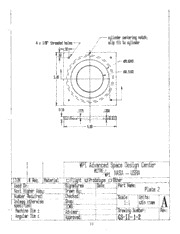Table Of Content/,,I_,.'_J- cA----
NASA-CR-192057
MICROGRAVITY IGNITION EXPERIAIENT
Worcester Polytechnic Institute
Mechanical Engineering Department
Worcester, MA
Professor Vahid Motevalli
William Elliott, Teaching Assistant
Keith Garrant, Ryan Marcotte
(NASA-CQ-I92057) MICROGRAV [TY N93-18053
Ic,r,[lT ICi',JFXO_RINENT (Worcester
Polyt_'chnic Inst.) 79 p
Unclas
G3/29 0141674
Abstract
The purpose of this project is to develop a flight ready apparatus of the
microgravity ignition experiment for the GASCan II program. This involved
redesigning, testing, and making final modifications to the existing apparatus. The
microgravity ignition experiment is intended to test the effect of microgravity on the time
to ignition of a sample of a-cellulose paper. An infrared heat lamp is used to heat the
paper sample within a sealed canister. The interior of the canister was redesigned to
increase stability and minimize conductive heat transfer to the sample. This design was
fabricated and tested and a heat transfer model of the paper sample was developed.
Authorship
We feel that both of us contributed equally to all portions of this project.
--- ii
Acknowledgements
Wewouldlike to thankthemanypeoplewhoassisteduswith our project:
ProfessorVahidMotevaUi,ouradvisor
ProfessorJimDuckworthandRyanMarcotte,fortheelectricalengineering
portion of thisproject
ProfessorBill Durgin, for hisvaluableassistance
William J.Elliot, for histimeandpatience
ToddBillings, for histimeandeffort
MITRE Corporation
1°°.11
Table of Contents
Nomenclature .......................................... v
Introduction ........................................... 1
Previous Projects ....................................... 4
GASCan II ........................................... 6
Experimental Apparatus ................................... 8
Sequence of Experiment in Space ............................. 16
Experiment Revisions ..................................... 22
Preflight Procedure .................................. 33
Testing Procedure ....................................... 35
Low Temperature Testing .............................. 35
Vibration Testing ................................... 37
Ground Based Data Acquisition .......................... 38
Recommendations ....................................... 40
Bibliography .......................................... 41
Appendix A - Aluminum Oxide Properties ........................ 44
Appendix B - Vibration Specifications ........................... 46
Appendix C - 1991-1992 MQP Budget .......................... 49
Budget ......................................... 49
_- iv
Nomenclature
ot- absorptivityof paper
C - specificheat
d - paperthickness
E_,,,_-dEnergy stored in paper
e - emissivity
I - heat flux
- convective heat transfer
qCOIIV
(t_o,,,t - conductive heat transfer
cl,oz - radiative heat transfer
p - density
a - Boltzman constant
T, - sample temperature
T® - ambient temperature
t - time
V
Introduction
One of the most important issues for long term space occupation, such as in a
space station, is fire safety. The very low gravity condition in space can drastically
affect the phenomena of combustion and fire. In order to maintain fire safety, the
initiation of the combustion phenomenon, ignition, must be understood. While ignition
has been studied, the effect of a microgravity environment on the ignition process is not
completely understood. The purpose of this project is to determine how the microgravity
environment affects ignition time.
A major factor in the ignition process is heat transfer. As a fuel source is heated,
products are released due to molecular breakdown of the sample. This process is
referred to as pyrolysis. These products mix with the surrounding air and, when a
sufficient amount of heat has been transferred to the sample, make ignition possible.
There are three ways in which heat is transferred into or away from an object.
These are radiation, conduction, and convection. Heat may be transmitted by the
emission and absorption of radiation. In addition to heat transfer due to radiation, there
is heat transfer due to the contact of two objects of different temperatures. This is
referred to as conductive heat transfer. Finally, heat may be transferred by convection
currents in the air.
Convection currents result from buoyancy forces caused by earth's gravity.
When a substance is hotter than the surrounding air, the temperature of the air near the
surface of the substance increases because of the transfer of heat. Convection currents
force the less dense heated air to rise away from the hot substance and the cooler, more
denseair to sinktothesurfaceof thesubstance,asshownin figure 1.
Heated Air
Convection Currents
on Earth
Figure 1
Due to the lack of gravity in a microgravity environment, convection currents are
not present. This lack of convection currents causes a cloud of heated air and pyrolysis
products to form around the object, as shown in figure 2. This will cause a reduction
in the heat transferred away from the object, increasing the object's temperature,
therefore decreasing the time to ignition. The absence of convection currents also
prevents the cooler, oxygen rich air from sinking towards the object. It is possible that
the lack of this oxygen may stop ignition from occurring at all. The purpose of this
experiment is to determine how these conflicting processes affect the time to ignition by
2
collectingandcomparingdataregarding ignition in microgravity and on earth, and
analyzing the results.
Oxygen (Cool Air)
Lack of Convection
in Microgravity
Figure 2
3
PreviousProjects
The microgravityignition experimentis a continuingproject. The first Major
Qualifying Project (MQP), on this project was completedin 1986. This project
determinedthepurposeof theexperimentandresultedin constructionof a prototype.
In addition, varioustypesof sensorswereinvestigatedfor the measuremenot f flux,
temperature,andignition(Blacker,etal., 1986).
Later groups considered many different substancesfor the test sample.
Eventually,NationalBureauofStandardsa-cellulose (paper) was selected, for its relative
consistency. This was chosen because the properties of the paper were relatively
constant, and the heat required to ignite the paper is not excessive (Forget, et al., 1990)
The initial combustion chamber was redesigned by the 1990 MQP group. The
1991 MQP group investigated the reliability of the equipment for the experiment. They
discovered that the moisture content of the o_-cellulose paper affected the time to ignition.
A procedure for drying the test sample was then developed. In addition to this, and their
development of the alignment apparatus and procedure, low temperature testing of the
experimental components was conducted (Forget, et al. 1990; Maranghides, Roy, 1991).
Modifications in the chamber have been made by this years team.
Previous projects also considered many possible heat sources. An Argus type 44
infrared heat lamp with a gold plated reflector was chosen for the heat source. The 1991
MQP group designed and fabricated a lamp alignment apparatus. Using this device they
developed a procedure for aligning the bulb both horizontally and vertically. This
focuses the lamp and allows the point of maximum heat flux to be concentrated on the
4

